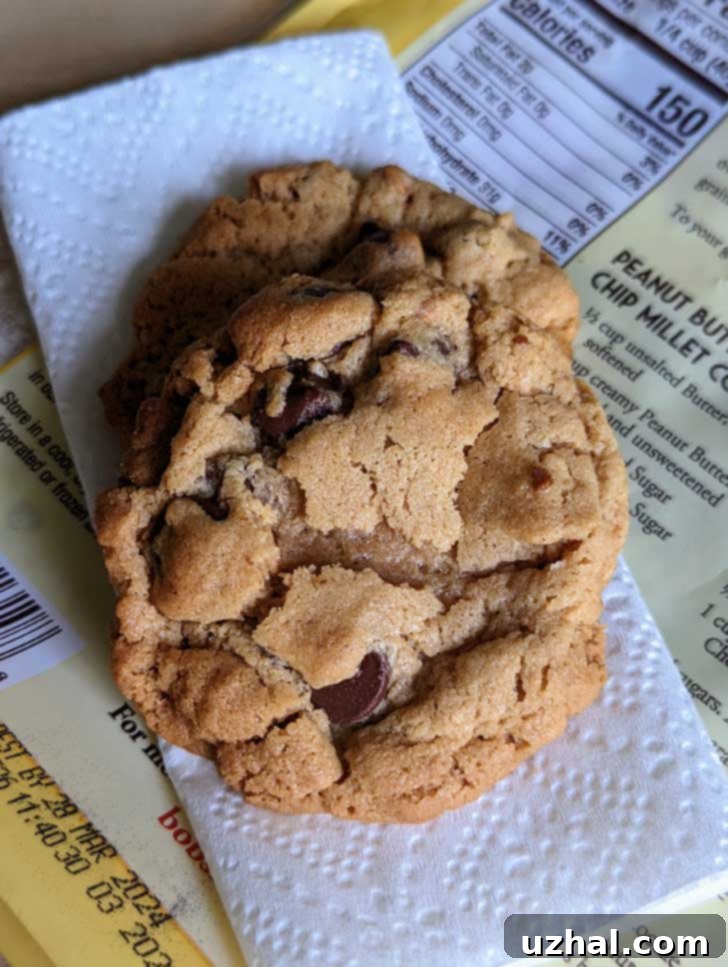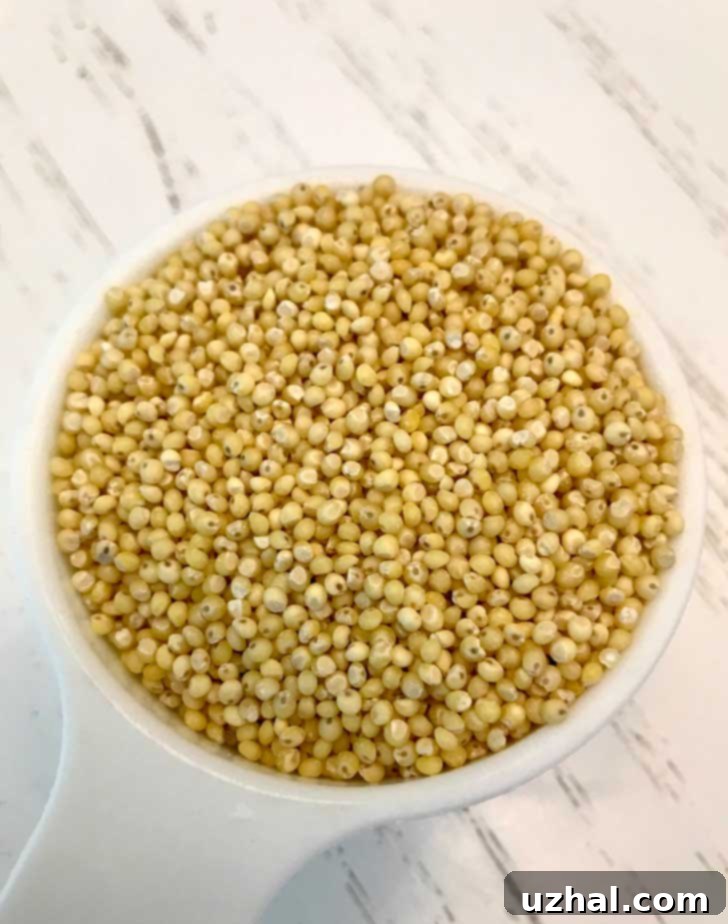Discover the Magic of Millet Flour: Irresistible Gluten-Free Peanut Butter Chocolate Chip Cookies
Venturing into the world of alternative flours can be an incredibly rewarding experience for any baker, especially when seeking gluten-free options or simply looking to broaden their culinary horizons. While sorghum flour has long been a favorite for its versatility and mild flavor, there’s a new star shining brightly in my kitchen: millet flour. My latest baking triumph, a batch of Millet Peanut Butter Chocolate Chip Cookies, has proven to be an absolute revelation! These cookies aren’t just good; they’re truly exceptional. They boast a beautifully chewy texture characteristic of classic peanut butter cookies, adorned with those delightful cracks and crevices that hint at their homemade charm. The dominant flavor remains the comforting richness of peanut butter, but the millet flour plays a crucial role, contributing to their appealing crackly exterior and offering a wonderful, wheat-free alternative for your baking needs.

Baking with Millet Flour: A Gluten-Free Game Changer
Millet, often misunderstood and primarily associated with birdseed, is actually an ancient grain (botanically a seed) that has been cultivated for thousands of years and is a staple food in many parts of the world. Its impressive nutritional profile and naturally gluten-free nature have propelled it into the spotlight of modern healthy eating and baking trends. It’s renowned for being easily digestible, making it a fantastic choice for those with sensitive stomachs or gluten sensitivities. This surge in popularity means millet flour is now far more accessible than it once was. I’ve personally spotted it in major grocery chains like Wegmans and Whole Foods, and numerous reputable brands are available for online order.
A word of caution for online shoppers: always double-check your order to ensure you’re getting millet flour and not whole millet seeds. I made this mistake once, much to my chagrin! Thankfully, unlike other whole grains (like Teff, which I also accidentally ordered in its un-milled form), whole millet seeds are relatively easy to grind into flour using a high-powered blender or a grain mill at home. This makes it a forgiving grain for those accidental purchases. However, for convenience and consistent results, sourcing pre-ground millet flour is often the best approach for baking endeavors.

Understanding Millet’s Flavor and Texture Contributions
Beyond its flour form, whole millet can be boiled and enjoyed much like quinoa, a versatile side dish or addition to salads. With a three-pound bag of whole millet now residing in my pantry (thanks to my earlier ordering mishap), I’m certainly planning to explore its culinary uses beyond baking! However, my primary focus recently has been on harnessing the unique properties of millet flour in my sweet treats. In baking applications, millet flour contributes a delicate touch of sweetness and helps significantly with the rise and structural integrity of baked goods. It imparts a subtle, slightly sweet flavor that I find incredibly pleasant and adaptable.
Many describe millet’s flavor as “nutty,” a descriptor I often try to refine. What kind of nut, specifically? Is it almond-like, cashew-like, or more like a roasted pecan? I’ll have to conduct further “research” by eating more of these delightful cookies to precisely pinpoint that nuanced flavor! What I can definitively say is that it doesn’t overpower other ingredients, making it an excellent base flour that allows primary flavors, like peanut butter in this recipe, to truly shine while adding its own gentle character and improving the overall texture.

The Ultimate Gluten-Free Peanut Butter Chocolate Chip Cookies
When it comes to gluten-free peanut butter cookies, these Millet Peanut Butter Chocolate Chip Cookies stand head and shoulders above many others. A common issue with gluten-free baked goods can be a grainy or gritty texture, but these cookies are delightfully smooth and chewy, without any unpleasant grittiness. The combination of millet flour with a touch of tapioca flour creates a perfect balance, offering elasticity and a desirable chewiness that can be hard to achieve in gluten-free recipes.
Even my discerning “food critic” (my daughter, Fuzz) commented on their excellent flavor, suggesting she could perhaps detect the subtle notes of millet more keenly than I could. Our collective consensus was that while semisweet chocolate chips are fantastic, creamy milk chocolate chips would be equally, if not more, wonderful. For the next batch, I’m definitely planning to experiment with milk chocolate to see how it complements the rich peanut butter and distinct millet base. This recipe truly showcases how gluten-free baking can be just as, if not more, satisfying than traditional wheat-based treats.
Tips for Perfecting Your Millet Cookies
- **Chilling the Dough:** Don’t skip the chilling step! Even a short 30-minute chill helps the flavors meld, makes the dough easier to handle, and prevents the cookies from spreading too much in the oven, ensuring those beautiful cracks form.
- **Oven Temperature:** While 350°F is a standard, experimenting with 375°F (as mentioned in the recipe notes) can sometimes yield a slightly crispier edge and a more pronounced crackle. Know your oven and adjust accordingly.
- **Don’t Overbake:** Gluten-free cookies can go from perfectly chewy to dry and crumbly very quickly. Watch for the edges to just begin browning. They might seem slightly underdone in the center, but they will firm up as they cool.
- **Ingredient Quality:** High-quality creamy peanut butter (unsweetened is preferred to control sugar levels) and good chocolate chips make a significant difference in the final taste.
- **Millet Flour Brands:** As shown in the comparison photo, different brands or even home-ground millet can slightly alter the cookie’s appearance. Experiment to find your favorite, but rest assured, the deliciousness remains consistent.
Why Millet Flour is a Must-Try
Incorporating millet flour into your baking regime opens up a world of possibilities, especially if you’re navigating gluten sensitivities or simply seeking healthier alternatives. Nutritionally, millet is a powerhouse, offering good amounts of protein, fiber, and essential minerals like magnesium, phosphorus, and manganese. Its mild flavor profile makes it a fantastic foundational flour that doesn’t overwhelm other ingredients, ensuring your recipes retain their intended taste. Furthermore, its ability to contribute to structure and a desirable texture in gluten-free baking makes it an invaluable addition to any pantry.
This journey into millet flour has been incredibly rewarding, showing that gluten-free baking doesn’t mean sacrificing flavor or texture. These Millet Peanut Butter Chocolate Chip Cookies are a testament to that, offering a delightful combination of classic flavors and a satisfying experience that caters to a variety of dietary needs. They are a perfect example of how exploring diverse flours can lead to exciting and delicious discoveries in your kitchen.
- Super Nutty Peanut Butter Cookies
- Mini Peanut Butter Cup Brownies
- Double Chocolate Peanut Butter Cup Cookies
- One Bowl Peanut Butter Milk Chocolate Cookies
- Peanut Butter Cupcakes with Peanut Frosting
Recipe: Millet Flour Peanut Butter Chocolate Chip Cookies

Millet Flour Peanut Butter Chocolate Chip Cookies
Anna
Pin Recipe
Ingredients
- ¾ cup millet flour (120 grams)
- ¼ cup tapioca flour (30 grams)
- ½ teaspoon baking soda (3 grams)
- ½ teaspoon baking powder
- ½ teaspoon salt
- 1 stick unsalted butter softened (114 grams)
- ¾ cup creamy peanut butter unsweetened (200 g)
- ¼ cup granulated sugar (60 grams)
- ¾ cup packed brown sugar (165 grams)
- 1 egg (50 grams)
- 1 teaspoon vanilla extract
- 1 cup semisweet or milk chocolate chips (225 grams)
Instructions
-
Whisk together flours, baking soda, baking powder and salt. Set aside.
-
With an electric mixer, beat the butter, peanut butter and sugars until creamy. Add egg and vanilla and beat until light and fluffy.
-
Add the flour mixture and stir until blended.
-
Stir in chocolate chips. Cover and chill dough for about a half hour or until ready to use.
-
Preheat oven to 350°F. (375 also works).
-
Line a baking sheet with parchment paper. Using a medium size cookie scoop, scoop up balls of dough and arrange about 2 ½ inches apart on the baking sheet.
-
Bake for 12-15 minutes, or until the edges begin to brown. Let cool on the baking sheet for about 5 minutes, then transfer to a wire rack to finish cooling.
